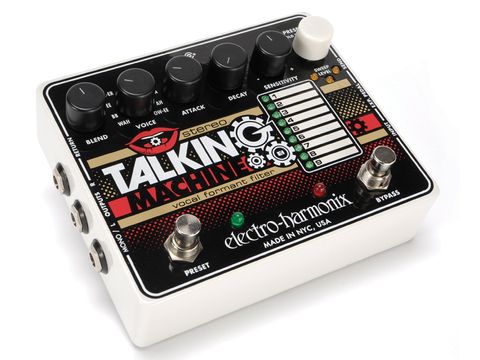You know the main riff from Livin' On A Prayer? Well, Richie Sambora created that sound with a talk box.
Effectively, this bit of kit pumps the output of your amp down a plastic tube and straight into your gob. A mic is then used to pick up the sound from your mouth (which is now acting like a filter) and sends it to a PA system for everyone to hear.
It sounds complex and it is a bit, plus it will rattle your fillings. Electro-Harmonix's new Stereo Talking Machine looks like it could take some of the hassle out of creating vocal-style filtered effects with your guitar.
There are no mics or tubes here. Instead, you get seven different 'vowel' voices and two more 'standard' filter sounds in the shape of the Wah and Bassballs modes.
Each vowel voice sweeps between two shapes to produce a pseudo-talking effect and the pedal's controls affect how this happens over time. The Sensitivity dial lets you set a threshold for the filter, then listens to the incoming level of your guitar and starts its sweep beyond your limit.
There's also control over the filter's envelope with the Attack and Decay controls. Attack governs the rise-time of the filter or how long it takes to get from the start of the sweep to its peak. Decay controls how quickly it rolls back down.
Faster times might make it harder to hear the transition between the vowel shapes, while slower times can give a more exaggerated effect, but it's really a case of finding a balance. The sweep can also be reversed with the Sensitivity control, potentially doubling the amount of sounds you can coax from the pedal.
In wah pedal terms, this is the equivalent of starting in either the heal or toe-down positions. If this all sounds like you've entered the domain of a cramped-handed keyboard player, then relax. You can also plug in an expression pedal to manually push the filter between vowel shapes with your foot and avoid the headache of setting envelope times, just like a regular wah.
As well as the visible controls, there are also some hidden auxiliary functions, accessed by pressing the Presets dial to put the pedal in aux mode. From here, the standard controls are replaced with a master volume, fuzz circuit (level and gain) and synth-style LFO (low frequency oscillator) control of the filter, with two waveshapes: triangle and sawtooth. The LFO works best for chordal work; think funky swirls.
Performing all of these changes isn't very stage-friendly, so once you've set your sound, you can save it to one of the nine internal memory slots to recall later.
The sounds are great, but you may just pick two or three shapes and stick with them. Replicating the human voice with a guitar is never going to be a simple task and, EHX's presets aside, this isn't the sort of effects unit you'll dip in and out of.
It takes a bit of getting used to and we'd certainly recommend getting an expression pedal. The reward is refreshing filter sounds that get you close to the classic 'talking guitar' effect.


